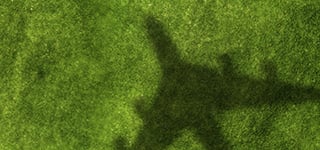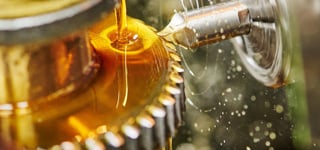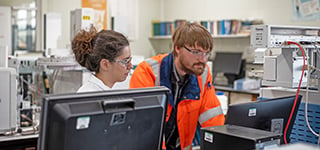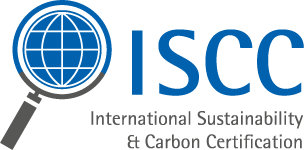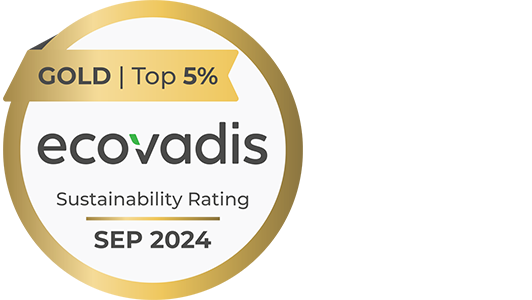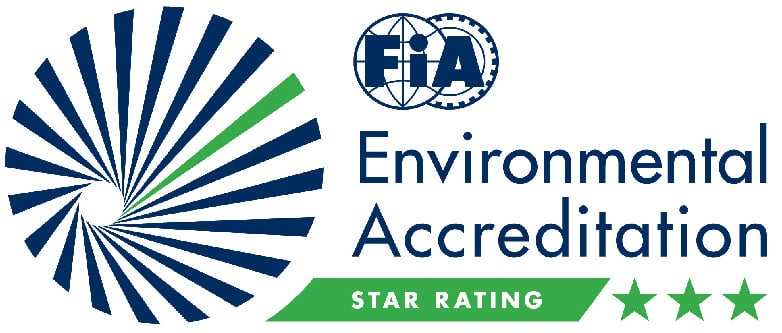Haltermann Carless is a leading international supplier of solutions for high-value hydrocarbon specialties and solvents. The company belongs to the HCS Group and operates state-of-the-art production, processing and blending facilities in Europe and the United States. This allow us to manufacture a comprehensive range of speciality products, such as performance solvents and fuels, special aromatics, pentanes, middle distillates and oil and gas products to serve various industries. For the agrochemicals industry, for example, Haltermann Carless is a leading supplier of C10 and C12 heavy aromatics. For over 70 years, it has been manufacturing key products, well-known in the industry under the trademark Caromax®.
Haltermann Carless (HCS Group) leading international provider of solutions for high-value specialty hydrocarbons. We currently operate state of the art refining, processing and blending facilities in Europe and the US that allow us to produce a wide variety of speciality products.
We are a leading global producer of C10 and C12 Heavy Aromatic Solvents to the Agrochemical, Fuel Additive and Oilfield chemical industries.
Haltermann Carless is a global supplier of C12 aromatics into the industry.
Agrochemical Formulations
Oil Dispersant (OD) and Emulsifiable Concentrate (EC) formulations require a strong aromatic solvents to keep the active ingredients in solution and stable over time and varying storage and transport conditions.
Agrochemical active ingredients have a range of solubilities depending on their functional groups and molecular weight. Some active ingredients may not be soluble in water or become unstable over long periods of storage and handling. In some cases, suitable dissolution into a liquid phase and storage stability is provided by the use of hydrocarbons which would act as a carrier fluid.
Haltermann Carless Special Aromatic fluids are heavy aromatic products with excellent solvency, which allows them to be utilised in even the most sensitive agrochemical formulations. They are well known in the industry as our Caromax® range and we have been manufacturing our key products in this range for over 70 years.
Haltermann Carless Caromax® solvents are compliant with global regulatory requirements and have a wide range of approvals globally with many agrochemical producers. Haltermann Carless also takes the approach where we have a passion for working closely with our customers to develop tailored special aromatic solvent formulations. These bespoke formulations are tailored to a formulator’s active ingredient’s solubility boundaries.
Types of formulations and the role of Caromax® solvents
With the aromatic content of the Caromax® grades typically around 99.9%, they are offered two main boiling ranges, Caromax® 20 and Caromax® 28. Two levels of naphthalene depleted grades are available in all, typically less than 1% and less than 0.1%.
| Standard Grade | Low Naphthalene Grade | Extra-low Naphthalene Grade |
| C10 Range
180℃ – 220℃ |
Caromax® 20 | Caromax® 20 LN | Caromax® 20 XLN |
| C12 Range
210℃– 300℃ |
Caromax® 28 | Caromax® 28 LN | Caromax® 28 XLN |
| Grade | Typical Boiling Range | Typical Naphthalene Content |
| Caromax® 20 | 185℃– 216℃ | 7.00% |
| Caromax® 20 LN | 182℃– 196℃ | 0.60% |
| Caromax® 20 XLN | 183℃– 196℃ | 0.05% |
| Caromax® 28 | 229℃– 289℃ | 7.00% |
| Caromax® 28 LN | 247℃– 299℃ | 0.50% |
| Caromax® 28 XLN | 249℃– 298℃ | 0.07% |
The majority of Caromax® products are applied in the development and production of Emusifiable Concentrate (EC) and Oil Dispersant (OD) formulations.
An EC formulation usually contains an active ingredient, an emulsification agent and a petroleum based solvent to keep the solution stable and in solution. Being one of the most adaptable formulations types, EC formulations are employed in agricultural and forestry applications with agrochemical formulations being the largest.
OD formulations consist of an active ingredient that is suspended in an oil phase with dispersants, emulsifiers and rheology modifiers. OD formulations can prove to be more sensitive to formulate as the active ingredient need to be insoluble in the oil phase and stable in extended storage conditions.
Solvency Challenges
Crop formulations can be affected in numerous ways by the different solvent compositions depending on the type of formulations. In ECs for instance, cold stability is affected by the solvent composition where polarity is key in solubilising the active ingredient. In EW formulations (emulsion, oil in water) droplet size of the oil phase is influenced by the viscosity of the oil.
All Caromax® products are complex mixture of heavy aromatics chemistries of C10 and C12 nature for the Caromax® 20 and Caromax® 28 range respectively. The distribution of these complex chemistries has a significant impact on the solvency properties and long term stability of the formulated agrochemical product. Years of formulation experience has led us to our highly specialised Caromax® range – optimised for the agrochemicals market. We have worked closely with our customers and end users to identify the perfect composition of C12 products to support most EC formulations.
Solvency and Solubility Studies
C12 aromatic solvents are the predominant hydrocarbons for stabilising and solubilising OD and EC formulations. At times, C10 aromatic solvents are used as well, but due to their light boiling ranges, are sometimes avoided for safety and handling reasons.
In view of this and a trend of the industry to move to C12 aromatics solvents, Haltermann Carless has embarked on a solvency and solubility study to further understand how our products behave and provide solvency power to agrochemical formulations. The commercial aim of the initial study was to help advice our agrochemical customers on the expected solvency performance of our products to help drive tailored solutions.
Using an internally developed method, dissolution curves were generated for an active ingredient in various Caromax® solvents. By plotting the temperature of dissolution against the weight of active ingredient gradually added, the dissolution curves could be generated and compared for each Caromax® solvent. Whilst the method needs further development and adaptation to various physical and chemical qualities of active ingredients, it provides some sensible initial results.
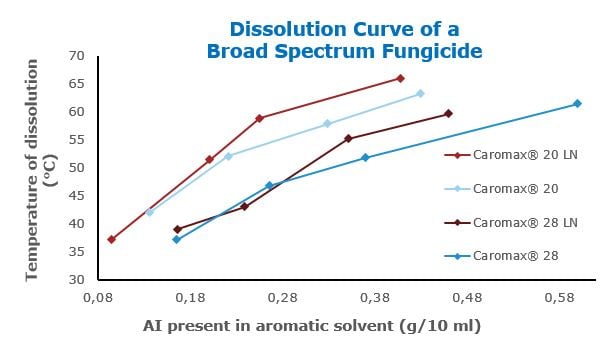
The graph above demonstrates some interim results of our studies. The Caromax® products whose curves reach the top right hand side of the graph offer the best solvency for the active ingredient tested. This means that a formulator would benefit from using Caromax® 28 instead of Caromax® 20, as they would require less solvent for their final formulation. This would lead to significant cost saving potential for the formulator.
It should be recognised that there are several hundreds of active ingredients in the herbicide, fungicide and pesticide industries and this trend needs to be clarified and further explored. Haltermann Carless research efforts aim to further optimise the performance of the Caromax® solvents by finding the right balance between suitable AIs and solvency. These learnings will support our formulators and customers to select the most suitable Caromax® product.
Regulatory and Logistics
Caromax 20®, Caromax® 20 LN, Caromax® 28 and Caromax® 28 LN are fully REACH registered and EPA approved for use as an inert ingredient in pesticide formulations applied to growing crops. These products are included in the ‘List of Trade Names and Inert Ingredients’ on the EPA’s website. They are also fully approved by PMRA in Canada and are on the ‘Published PMRA List of Formulants’.
With storage and distribution locations in both North and South America and Europe, we are in a position to supply our products to any location globally. We welcome the opportunity to run joint research and development programs that cater for the legislative, environmental or formulation challenges of the future.
Author:
Suwanie Wilathgamuwage, Technical Services and Development Manager, Haltermann Carless
Technical Assessment:
Dr. Andrea Rodriguez Barzano, Senior Development Chemist, Haltermann Carless
Luke Girling, Development Chemist, Haltermann Carless
Publication:
This article has been published in Agropages Edition in October 2019. Click here to review the article on Agropage Website.
Haltermann Carless Agrochemicals Business:
To learn more about, please click on the following link: Special Aromatics business and Caromax® product range.


